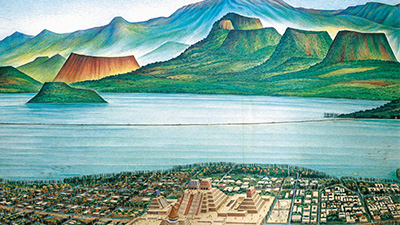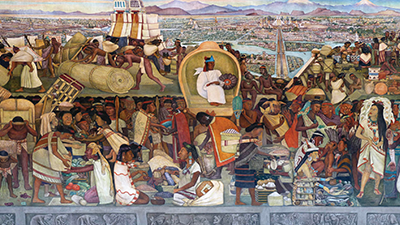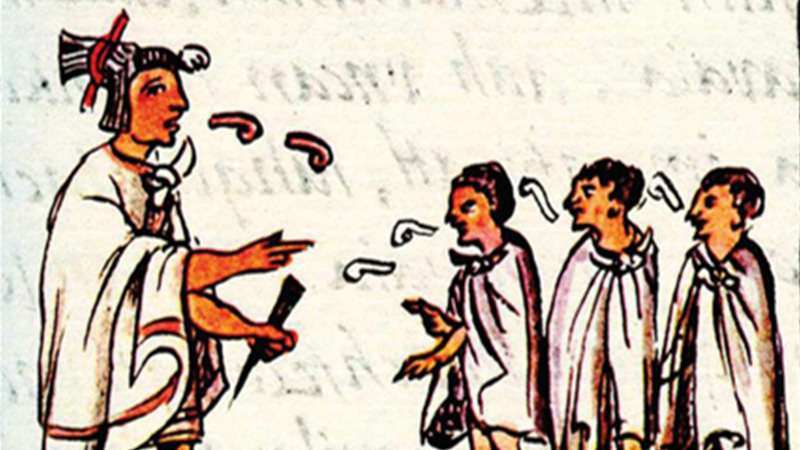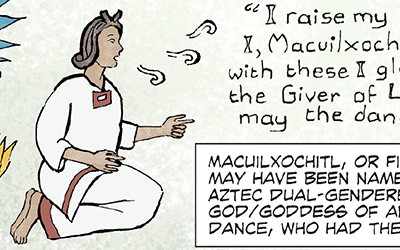State Building in the Americas
Teacher Resources
Driving Question: How did states in the Americas develop and why did they change over time?
Afro-Eurasia wasn’t the only place where stuff was happening from 1200 to 1450. That’s probably pretty obvious to you, considering there’s a whole other hemisphere out there! As you make your way through the history of the Americas, you’ll notice some big differences between societies in those two geographic areas. But there were also many similarities.
Learning Objectives:
- Explain how states in the Americas developed.
- Describe how states in the Americas changed over time.
- Use close-reading strategies to examine the development of states in the Americas.
- Use change over time skills to evaluate the development of societies in the Americas.
Vocab Terms:
- continuity
- evidence
- narrative
- perspective
- polytheistic
- tribute
Opener: State Building in the Americas
To teach this lesson step, refer to page 2 of Lesson 1.4 Teaching Guide.
Educators in our Community Forum share ideas in this thread about reinforcing the themes throughout the year.
Six words is not a lot. Challenge yourself to tell a six-word theme story!
The Americas 1200–1450
To teach this lesson step, refer to page 2 of Lesson 1.4 Teaching Guide.
Many diverse and advanced civilizations existed in the Americas well before the arrival of Europeans around the end of this period. In this article you will explore some of these societies to analyze the similarities and differences between them—and you may see commonality with other civilizations you have studied in this unit!
-
Guiding Questions
-
Before you read
Preview the questions below, and then skim the article. Be sure to look at the section headings and any images.
While you read
Look for answers to these questions:
- What type of state did the Haudenosaunee have, and how was it governed?
- What type of state did the Aztec have, and how was its diverse population ruled?
- What evidence is there of connections between Aztec and Mayapan societies?
- What kind of state did the Inca have, and how was it governed?
After you read
Respond to the following questions:
- What factors stand out to you as particularly distinct and important in the way communities were organized in the Americas in this period?
- How are the societies in the Americas similar or different to other parts of the world you have studied in this period?
Pre-Colonial Caribbean
To teach this lesson step, refer to page 4 of Lesson 1.4 Teaching Guide.
This blog post, Engaging students with video, provides four steps in engaging students with videos.
The Caribbean region became an epicenter of globalization in the post-1492 world—but what was life like for the Indigenous people of this region before then? And how did their migratory patterns affect the Caribbean?
-
Guiding Questions
-
Before you watch
Preview the questions below, and then review the transcript.
While you watch
Look for answers to these questions:
- What were the first two major moments of migration to the Caribbean islands and when did these take place?
- Dr. Hofman states that the soil must be opened like a book to learn about early Caribbean peoples. What types of information can archaeologists learn from the soil?
- What belief systems were in evidence in the early period of migration? How did these change in the later periods?
- How do we know that there were continued contacts and exchanges between islands and between the Caribbean islands and the mainland of Central and South America in the pre-colonial period?
- How did the Indigenous Caribbean peoples help the Spanish and what occurred as a result of this help?
- Who were the Kalinago and where did they settle after the arrival of the Spanish?
After you watch
Respond to the following questions:
- Dr. Hofman states that 1492 marks “the beginning of the true globalizing world.” What evidence does she give to support this statement, and do you agree with her? Explain your reasoning.
- How does the history of the pre-colonial Caribbean support, extend, or challenge what you’ve learned about societies in this unit?
Key Ideas
Time Travelers Journal
Imagine you’re a time traveler in the Americas from 1200 to 1450 CE. Where would you choose to visit and what would you write about?
Long-Distance Trade in the Americas
To teach this lesson step, refer to page 5 of Lesson 1.4 Teaching Guide.
Trade and trade routes have been an important part of our story thus far. This importance is still evidence in our studies of the Americas c. 1200–1450 CE. But how much do we really know about trade in the Aztec Empire during this time?
-
Guiding Questions
-
Before you read
Preview the questions below, and then skim the article. Be sure to look at the section headings and any images.
While you read
Look for answers to these questions:
- What were some barriers to trade in Mesoamerica?
- What made Teotihuacan an important trading center?
- What sort of goods traveled across long-distance routes in the Americas?
- Why don’t we know very much about merchants in Teotihuacan? Why do we know more about merchants in Tenochtitlán?
- What was life like for merchants in the Aztec Empire? What roles did they play in the empire, other than trade?
After you read
Respond to the following questions:
- To what extent does this article explain how and why states in the Americas developed and changed over time from c. 1200 to 1450?
- Think about the region you live in. What environmental features would have made it easier or harder for you to trade with other regions if you had to carry all your trade goods only on your back or in a canoe?
Empires of the Americas: The Aztec and Inca
You can learn a lot about the Aztec and Inca by viewing both empires through the AP® themes of governance, economic systems, and social interactions and organization. Discovering how these themes were intertwined holds one of the keys to their power.
-
Guiding Questions
-
Before you read
Preview the questions below, and then skim the article. Be sure to look at the section headings and any images.
While you read
Look for answers to these questions:
- What powerful cities and communities controlled the Valley of Mexico in the early thirteenth century?
- How were Aztec beliefs intertwined with the state?
- What was the social structure of the Aztec Empire?
- What was the economy of the Aztec Empire based on?
- How did the Inca Empire emerge as a result of the development of technology, and how was the empire structured?
- What was the mit’a system and why was it important?
After you read
Respond to these questions:
- What factors led to the fall of the Aztec and Inca?
- How were the Aztec and Inca Empires similar in terms of governance?
Communities of Movement
To teach this lesson step, refer to page 6 of Lesson 1.4 Teaching Guide.
This thread in the Community Forum discusses bringing Indigenous voices into the classroom.
People are used to origin stories as they relate to superhero movies, such as Superman or Batman. But did you know that Ancestral Pueblo origin stories existed well before blockbuster films?
-
Guiding Questions
-
Before you watch
Preview the questions below, and then review the transcript.
While you watch
Look for answers to these questions:
- How does the story of the Ancestral Pueblo challenge world-historical narratives about agriculture and complex societies?
- How does Theresa Pasqual characterize Pueblo origin stories?
- According to Dr. Natalie Martinez, why are these origin stories important today?
- According to Dr. Kurt Anschuetz, what are some strategies that Pueblo people used to thrive on the Colorado Plateau?
- How does Theresa Pasqual describe the movement of the Ancestral Pueblo people?
After you watch
Respond to the following questions:
- To what extent does this video help explain how and why states in the Americas developed and changed over time from c. 1200 to 1450?
- The people in this video suggest that oral histories should be taken seriously as historical evidence, on par with archaeological evidence. What do you think are the differences in what we can learn from archaeology and oral traditions? What do you think historians should do when the two types of evidence disagree?
Key Ideas
Closer: State Building in the Americas
To teach this lesson step, refer to page 7 of Lesson 1.4 Teaching Guide.
It has been said that a picture is worth a thousand words. What about poetic imagery? A picture painted with words may be worth just as much!
-
Guiding Questions
-
Before you read
Preview the questions below, and then skim the comic. Be sure to look at the section headings and any images.
Skim the full comic, paying attention to things like prominent colors, shapes, and types of text and fonts. How do you know where to start and which direction to read? What’s in the gutters (the space between panels)? Who is the focus of the comic? What big questions do you have?
While you read
Look for answers to these questions:
- Who was Macuilxochitl and how does she describe herself?
- She describes the Tenochtitlan (Aztec) conquest of Tlacotepec as “forays for flowers [and] butterflies.” What does this mean?
- She writes that Axayacatl spared the Otomi warrior partly because he brought a piece of wood and deerskin to the ruler? What does this tell you?
- How does the artist use art and design to emphasize and demonstrate the importance of tribute?
After you read
Respond to the following question: How does this biography of Macuilxochitl support, extend, or challenge what you have learned about the state and economy in Mesoamerica in this period?






